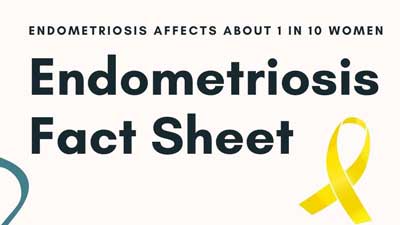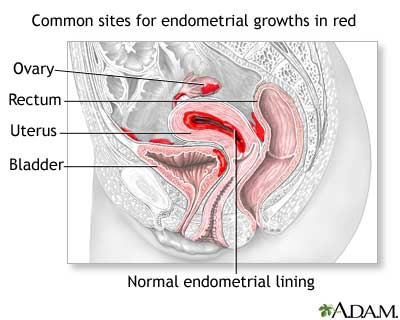Endometriosis Symptoms, Treatment, and Risk Factors
While endometriosis is a condition that affects about one in 10 women, it often goes undiagnosed for years. Endometriosis is a leading cause of infertility and affects up to half of women who experience infertility.
Endometriosis can contribute to a wide variety of symptoms, or produce no symptoms at all. The long list of endometriosis symptoms coupled with the lack of a simple screening tool for the condition contributes to the lengthy delay many women experience between onset and diagnosis.
Endometriosis is a painful, potentially life-disrupting disease that affects about 10% of all reproductive age women. Broader awareness of the condition and its widely varied symptoms can promote earlier diagnosis and improved management.
What Is Endometriosis?
The World Health Organization (WHO) describes endometriosis as “a chronic disease associated with severe, life-impacting pain during periods, sexual intercourse, bowel movements and/or urination, chronic pelvic pain, abdominal bloating, nausea, fatigue, and sometimes depression, anxiety, and infertility.”
In simple terms, endometriosis is caused by tissues similar to the uterine lining growing outside of the uterus. This tissue growth is responsible for the significant pain that can be associated with endometriosis, and can also make it difficult or impossible to conceive. Endometriosis is one of the most common causes of unexplained infertility in women.
Endometriosis is generally found in the pelvic cavity and can attach itself to any of the female reproductive organs including but not limited to the outside of the uterus, fallopian tubes, ovaries, uterosacral ligaments, peritoneum, and any of the spaces between the bladder, uterus, and vagina. Endometriosis can also involve other areas including the large and small bowel, appendix, diaphragm, lungs, and rectum.
What Are The Symptoms of Endometriosis?
Part of what makes endometriosis so hard to diagnose is that the symptoms can be broad and diverse. Pain is the most common symptom, but it’s also possible to have no active symptoms of endometriosis. Many women will experience some combination of the following symptoms:
- painful periods
- severe cramps
- migraines or lower back pain during your period
- chronic pelvic pain
- pain during and/or after sexual intercourse
- painful bowel movements
- painful urination
- vaginal bleeding or spotting between periods
- fatigue
- depression or anxiety
- abdominal bloating and nausea
- trouble getting pregnant
The list gets longer with less common endometriosis symptoms such as constipation, diarrhea, musculoskeletal pain, back pain, upper body pain, acid reflux, and headaches.
In addition to these symptoms, endometriosis can cause infertility in some women. Infertility is a byproduct of the effects of endometriosis on the pelvic cavity, ovaries, fallopian tubes or uterus.
Symptoms can range from mild to life-impacting, especially in the days right before your period. Because symptoms can vary so much from woman to woman both in type and intensity, many women go for years without a diagnosis. In this case, it is often only discovered upon deeper investigation into problems getting pregnant. These asymptomatic cases are part of why it is difficult to know exactly how many women have endometriosis.
If you’re experiencing the symptoms above or have a family history of endometriosis, it’s important to seek treatment early.
Who Is Most At Risk For Endometriosis?
Endometriosis can happen to any girl or woman, and affects more than 11% of American women between the ages of 15 and 44. However, some women are more likely to get endometriosis:
- Never had children
- Those who have shorter, more frequent cycles (fewer than 27 days)
- Those who have menstrual periods lasting longer than 7 days
- Family history (sister, mother, aunt) with endometriosis
- Lifestyle factors that increase estrogen levels in the body – Alcohol, caffeine, smoking, poor diet and limited physical activity can promote higher estrogen levels and increase the risk of endometriosis
How Is Endometriosis Diagnosed?
If your gynecologist suspects endometriosis, they may start by doing a pelvic exam or ordering an intra-vaginal ultrasound. These procedures can help rule out other problems, but the only way to diagnose endometriosis is through a surgical procedure known as laparoscopy. During the laparoscopy procedure the surgeon may collect a tissue sample for laboratory testing.
Tests to look for endometriosis include:
- Pelvic exam – Your ob/gyn provider may conduct a pelvic exam to feel for large cysts or scars behind your uterus
- Ultrasound – An ultrasound may be used to check for ovarian cysts from endometriosis
- MRI (magnetic resonance imaging) – An MRI may be used to obtain detailed images of the organs and tissues in your body
- Laparoscopy – Your gynecologic surgeon may perform a laparoscopy, which is a type of surgery to look inside your pelvic area
What Are My Treatment Options For Pain?
Currently, there is no known cure for endometriosis. There are treatments and medications available to alleviate pain and help with infertility problems. When considering treatment options for endometriosis, your gynecologist will take a number of factors into account.
Your age, the severity of your pain, the severity of the endometriosis growth, and whether or not you want to have children in the future will all impact the course of your treatment. Endometriosis may be treated with medication, surgery, or both. Surgery can help remove endometriosis tissue and may improve pain and fertility, and is usually reserved for women experiencing severe symptoms or fertility problems.
It’s important to work with a women’s health specialist with experience in the diagnosis, treatment, and management of endometriosis to determine the best course of action for your specific case of endometriosis.
If You Are Experiencing Endometriosis Symptoms, Schedule Your Visit Today
It can be hard to talk about endometriosis, but be assured that your Elite Women’s Health provider is here to help. Elite Women’s Health has two convenient locations in Fredericksburg and Spotsylvania to serve the Fredericskburg, Spotslyvania, and Stafford communities. We now also offer convenient telemedicine appointments for existing patients for certain types of visits.



